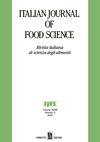构化植物蛋白的氨基酸和脂肪酸组成
IF 3.3
4区 农林科学
Q2 FOOD SCIENCE & TECHNOLOGY
引用次数: 0
摘要
纹理化蛋白质是肉类类似物的主要成分。本文评价了豌豆分离物、大豆分离物或豌豆分离物与燕麦蛋白结合所产生的织构蛋白的氨基酸和脂肪酸组成。蛋白质来源对营养成分有显著影响。除含硫氨基酸外,所有织构蛋白的氨基酸分布均符合FAO/WHO的建议。脂肪酸谱显示出多不饱和组分的优势,在干分馏豌豆混合物中最高。反式异构体含量均小于0.5%。本文章由计算机程序翻译,如有差异,请以英文原文为准。
Amino acid and fatty acid compositions of texturized vegetable proteins
Texturized proteins are the main ingredients of meat analogues. This paper evaluated the amino acid and the fatty acid compositions of texturized proteins produced by pea isolates, soy isolates, or dry-fractionated pea proteins, all combined with oat proteins. The nutritional composition was significantly affected by the protein sources. All the texturized proteins had a balanced amino acid profile, complying with the recommendations by FAO/WHO, except for the sulfur amino acids. The fatty acid profile showed the predominance of the polyunsaturated fraction, which was the highest in the dry-fractionated pea mixes. The trans-isomers’ content was lower than 0.5%.
求助全文
通过发布文献求助,成功后即可免费获取论文全文。
去求助
来源期刊

Italian Journal of Food Science
工程技术-食品科技
CiteScore
4.20
自引率
0.00%
发文量
33
审稿时长
>36 weeks
期刊介绍:
"Italian Journal of Food Science" is an international journal publishing original, basic and applied papers, reviews, short communications, surveys and opinions on food science and technology with specific reference to the Mediterranean Region. Its expanded scope includes food production, food engineering, food management, food quality, shelf-life, consumer acceptance of foodstuffs, food safety and nutrition, energy and environmental aspects of food processing on the whole life cycle.
Reviews and surveys on specific topics relevant to the advance of the Mediterranean food industry are particularly welcome.
 求助内容:
求助内容: 应助结果提醒方式:
应助结果提醒方式:


